Have Your Say: What is your key sustainability consideration when addressing demolition and/or installation?
At Design Insider we recognise the expertise within commercial interiors and we are proud to instigate conversations which inform, challenge & inspire the people who make our sector thrive.
We want to push the conversation on sustainability in to actions and having a greater understanding of how Commercial Interior Designers approach the installation and/or demolition stages of a commercial project is key to developing interior products and services which answer the sustainability, and client, brief. Therefore, we asked leading UK designers: What is your key sustainability consideration when addressing demolition and/or installation?
We we’re not surprised that the focus of the conversation was re-use and next month we will have a follow up question which looks at how conversations can be turned into actions including how Commercial Interior Suppliers can build a model for the re-use of pre-existing furnishings.
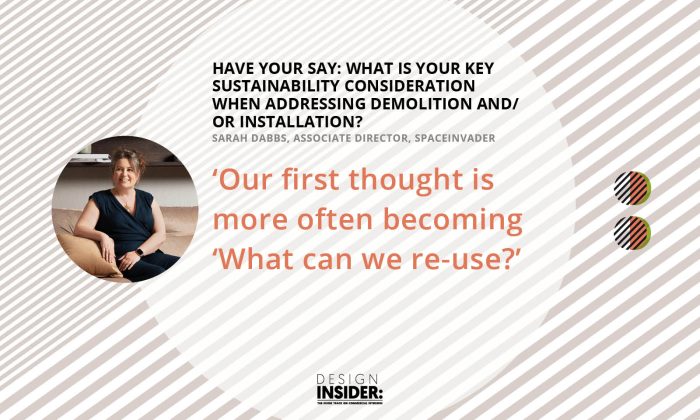
‘Our first thought is more often becoming ‘What can we re-use?’ Many spaces we review for clients have a previous fit-out element that’s possible to re-utilise. We start from a point of retaining as much as possible, whilst still meeting our client’s requirements, before looking at what has to be replaced and how to specify these elements in the most sustainable way. Many of our projects see furniture, partitions, ceilings, even whole buildings being given a new lease of life, as well as recycling or donating elements that no longer meet client needs.
Understanding that our new project will be someone’s future demolition means we keep in mind the end-of-life of everything we specify, trusting that sustainable choices will become more and more entrenched in the design and construction industry.’
Sarah Dabbs, Associate Director, SpaceInvader
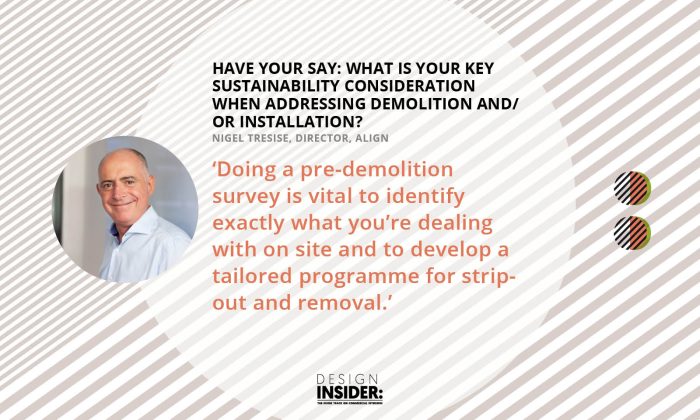
‘Doing a pre-demolition survey is vital to identify exactly what you’re dealing with on site and to develop a tailored programme for strip-out and removal. Some elements might require specialist removal, which takes longer and might be more expensive – but this is the hard truth about sustainable decisions. Knowing manufacturer names is key, as some carpet manufacturers, for example, will come and take products away to recycle themselves and save you the work. Addressing each material takes longer but offers a much better chance of retaining embodied carbon. We’re dismantling a blockwork wall block by block right now for re-use, where once a sledgehammer would have been the demolition default.’
Nigel Tresise, Director, align
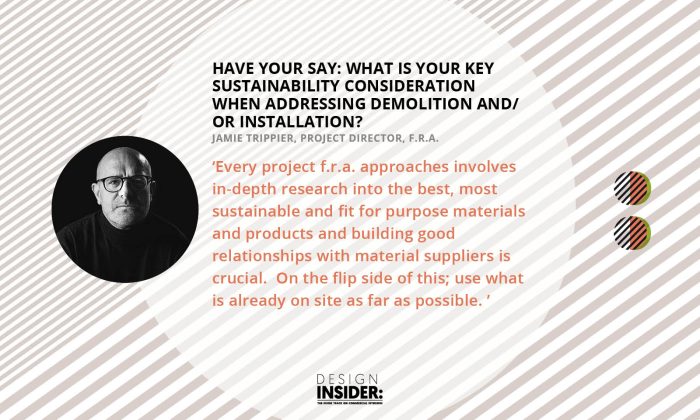
‘It may be obvious but in any installation the materials we use are key. Every project f.r.a. approaches involves in-depth research into the best, most sustainable and fit for purpose materials and products and building good relationships with material suppliers is crucial. On the flip side of this; use what is already on site as far as possible. With our project for Borough Yards for example, very little additional materials have been used and, aside from tenant directory signage which are simple fly posters made from recycled stock pasted directly on to walls, instead we found existing industrial brackets on the site that we turned, with a lick of durable paint, into whimsical faces which have been making hundreds of visitors smile and share on social media. So perhaps the ultimate sustainable consideration; use what you have.’
Jamie Trippier, Project Director, f.r.a.
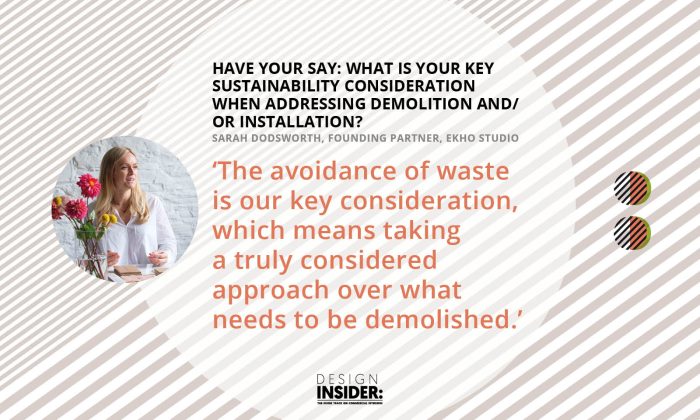
‘The avoidance of waste is our key consideration, which means taking a truly considered approach over what needs to be demolished. When it comes to new installed elements, there are so many touch points and so much to address around sustainability. Our pragmatic approach means there are no gimmicks or green gesturing. We’re committed to acting responsibly and see this as another way to flex our creative skills. There’s a joke here, I’m sure, about my own Yorkshire roots, but it’s actually very satisfying to cleverly reuse and repurpose where possible! It just makes sense to me.’
Sarah Dodsworth, Founding Partner, Ekho Studio
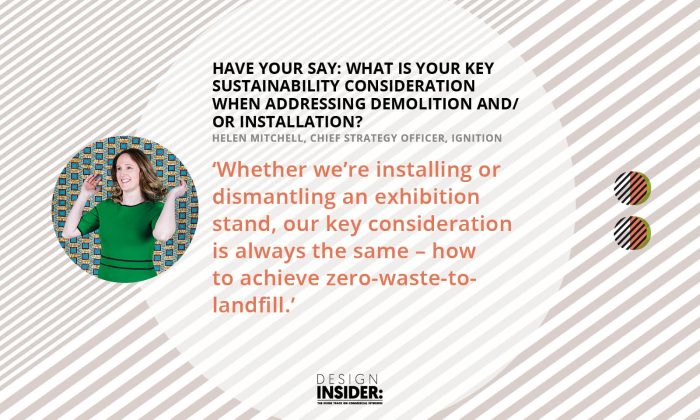
‘Whether we’re installing or dismantling an exhibition stand, our key consideration is always the same – how to achieve zero-waste-to-landfill. We address this through modular stands, designed for long life, with as many elements as possible retained for future use. Sometimes, issues are caused by event rules – US organisers insist on carpet being used for stand flooring for example. Historically, we’ve re-used that carpet to line our warehouse crates, but we’re really happy to see products like Interface’s CQuestTMBio coming along now, promising net carbon negativity.’
Helen Mitchell, Chief Strategy Officer, Ignition
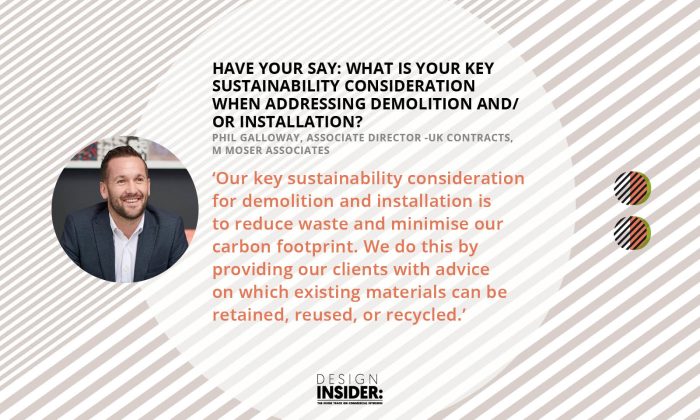
‘Our key sustainability consideration for demolition and installation is to reduce waste and minimise our carbon footprint. We do this by providing our clients with advice on which existing materials can be retained, reused, or recycled. Whether that’s repurposing timber for walls or repurposing existing flooring. We’re also identifying suitable waste contractors to divert waste from landfill.
To further reduce our carbon footprint our designers are sourcing local and sustainable materials and educating our clients on the benefits of this. We’re also assessing site delivery methods, such as using suppliers with electric vehicles or grouping deliveries together. Our contractors and team are also being advised to order less and reassess midway if more material is needed. Furthermore, we are tracking onsite power usage, and evaluating ways to reduce and minimise the use of unnecessary materials. We will continue to evaluate and assess how to reduce our carbon footprint.’
Phil Galloway, Associate Director -UK Contracts, M Moser Associates
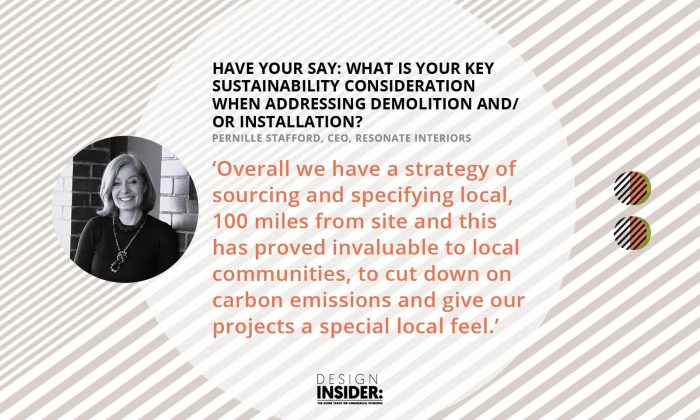
‘At Resonate we aim to tread lightly on our environment. Our proposed designs are sympathetic to the existing installation allowing us to retain, repurpose and reuse where possible. We Design to manufacturing sizes wherever possible, for instance, on a recent project we specified desks to 1400 sq which is the equal size of one sheet of linoleum, creating zero manufacturing waste, saving time, energy and emissions. We encourage our clients to upgrade recycle, upcycle everything from furniture to flooring to ceilings. Or modify existing i.e. change worktops to sustainable finishes but keep expensive leg bases and frames. We re-lamp light fittings with LED efficient ones instead of installing new. Overall we have a strategy of sourcing and specifying local, 100 miles from site and this has proved invaluable to local communities, to cut down on carbon emissions and give our projects a special local feel.’
Pernille Stafford, CEO, Resonate Interiors
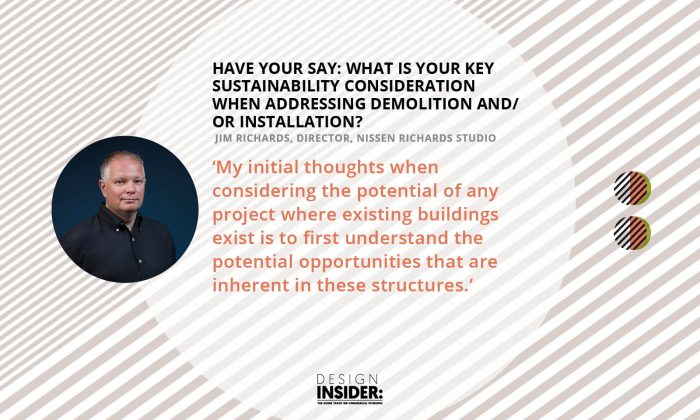
‘My initial thoughts when considering the potential of any project where existing buildings exist is to first understand the potential opportunities that are inherent in these structures. We would review this not only in an architectural, structural and environmental sense (and perhaps even in an archaeological manner), but also consider the intangible attributes that may exist – the everyday and familiar.
From a sustainable standpoint, each refurbishment or redevelopment project is different, and therefore a balance must be struck between the embodied carbon of the existing building itself against the potential operational energy savings that may occur either through refurbishment, extensive redevelopment or even complete replacement.’
Jim Richards, Director, Nissen Richards Studio
For our June Have Your Say article we are asking: How can the commercial interior sector turn our conversation on sustainability into actions?
We would love to publish your opinion, please email your answer (50-150 words), name, title, company and portrait to alys@designinsiderlive.com





Comments